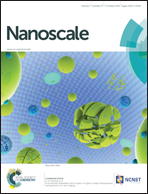Probing the mechanism of plasma protein adsorption on Au and Ag nanoparticles with FT-IR spectroscopy
Abstract
Protein–nanoparticle interactions are important in biomedical applications of nanoparticles and for growing biosafety concerns about nanomaterials. In this study, the interactions of four plasma proteins, human serum albumin (HSA), myoglobin (MB), hemoglobin (HB), and trypsin (TRP), with Au and Ag nanoparticles were investigated by FT-IR spectroscopy. The secondary structure of thio-proteins changed with time during incubation with Au and Ag nanoparticles, but the secondary structures of non-thio-proteins remained unchanged. The incubation time for structural changes depended on the sulfur–metal bond energy; the stronger the sulfur–metal energy, the less the time needed. H/D exchange experiments revealed that protein–NP complexes with thio-proteins were less dynamic than free proteins. No measurable dynamic differences were found between free non-thio-proteins and the protein–Au (or Ag) nanoparticle complex. Therefore, the impact of covalent bonds on the protein structure is greater than that of the electrostatic force.


 Please wait while we load your content...
Please wait while we load your content...